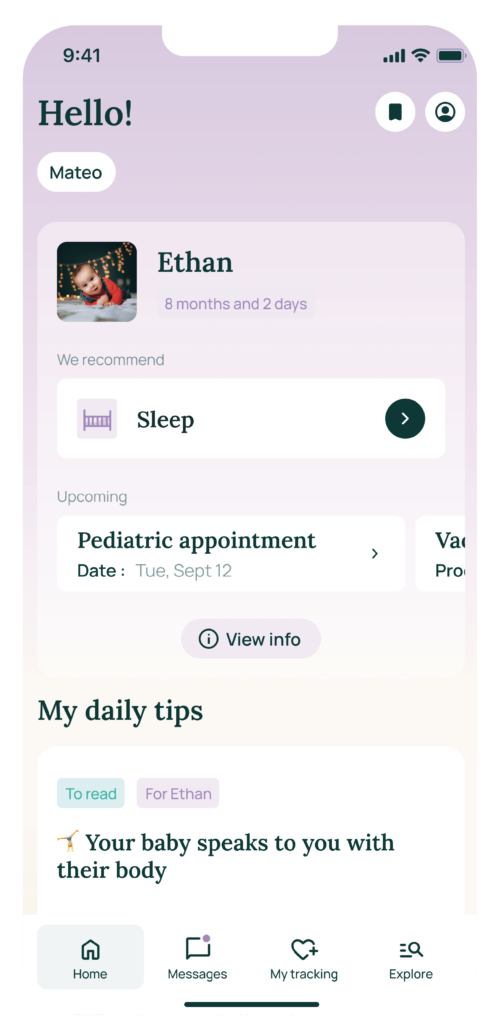
Our most viewed articles
All articles


Celebrating Halloween with a Baby: A Practical Guide for Parents

Flying with a Baby: Everything You Need to Know
Access more articles, tips, and Mya by downloading the May app
Try the app for free for 14 days.


Is it okay to have a baby sleep in your bed?

Breastfeeding and Baby Sleep

Mixed feeding: how to combine breastfeeding and bottle-feeding ?

The importance of burping in infants

Baby’s Mongolian spot: should you be concerned?

Baby crib bumper: a real danger?

Baby language: practical advice

Heat rash baby : causes and solutions

Baby laughs: understanding and encouraging their first laughs

Choosing the best laundry detergent for babies: a comprehensive guide

Finding your baby ugly
Infant (2 to 6 months)
What a beautiful sight it is to watch your baby grow… And so many questions! Let’s take a look together at the needs of an infant.
How to get an infant to sleep?
Ah… sleep! Your baby is now an infant and their sleep is changing. Sleep cycles are getting longer (they last about 70 minutes); the first adult-like sleep characteristic appears (quiet sleep turns into slow and deep sleep); the day/night cycle becomes increasingly clear; they begin to have enough energy to be less hungry at night; and their rhythm gradually aligns with their state of wakefulness!
However, all these changes make this a transitional period. In fact, your child’s sleep may be disrupted. Don’t panic! Let’s first remember that every baby has their own rhythm. Nothing unusual if your 4-month-old still wakes up at night for a bottle or to cry!
To help an infant fall asleep, remember that the key lies in setting up routines, gentle physical contact (long live maternal love, cuddles, and oxytocin!), and… patience.
Still, if you notice sleep disorders in your child, don’t hesitate to consult a pediatrician, especially in the first few months!
How to feed an infant?
As you can imagine, feeding is one of the baby’s physiological needs. Whether you’ve chosen to breastfeed or not, always ensure they receive proper nutrition!
If you’ve chosen to breastfeed, to make sure your child is eating enough, you can track their growth curve with a health professional once a month. Also, breastfed babies whose nutritional needs are met tend to have a good feeding rhythm (8 times or more per 24 hours) and appear satisfied and/or relaxed during feedings.
Note that if breastfeeding is painful for you, there are solutions. Don’t hesitate to speak to a lactation consultant or attend breastfeeding classes to get informed before giving birth! The nipple can be sensitive after feeding, but if pain appears or discomfort persists, consult a professional!
If you’ve chosen not to breastfeed your child, it’s recommended to offer bottles every 3 hours or so. However, breast milk, unlike formula, has the advantage of boosting the immune system of newborns.
To reduce the risk of regurgitation, don’t forget to burp your baby!
What are an infant’s needs?
An infant’s needs are physiological: they are survival needs. Regarding nutritional needs, be sure to choose a formula that’s appropriate. While breast milk is naturally designed to ensure infants’ health, it’s also important to be mindful of the quality of formula.
For breastfed infants, weaning depends on age and your personal situation. You can opt for partial weaning — that is, mixed feeding — and continue breastfeeding a few times a day. Starting from 4 months old, you can also begin to introduce complementary foods.
The length of breastfeeding depends on your plan and possibilities. There is, of course, a recommendation for exclusive breastfeeding for about 6 months, but it’s not mandatory!
How to evacuate a constipation plug?
Colds aren’t the only little troubles that affect infants and young children! They’re sometimes prone to constipation. As a reminder, constipation is defined as having fewer than 2 bowel movements per week and/or hard and difficult-to-pass stools. Some breastfed babies may have infrequent stools, but again, as long as they’re soft, it’s not a concern.
To trigger the release of a constipation plug, it’s essential to ensure your child is well hydrated to soften the stools. For babies over 6 months, you can also influence their digestion by varying their diet.
Remember: when it comes to your child, the best choices are always the ones you make. So whether it’s breastfeeding or bottle-feeding, restless nights… don’t let others’ judgments or opinions affect you! Every child grows and progresses at their own pace.


